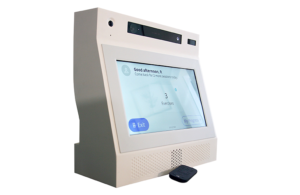The British medtech giant seeks to tap digital health to fuel growth in orthopedics. The Aria Home PT remote physical therapy device is the latest example.

The Aria Home PT [Image courtesy of Smith+Nephew]
It’s the size of a small flatscreen TV and shows up at someone’s house before they undergo knee or hip surgery at an ambulatory surgery center, interacting with them throughout the entire episode of care. Think interactive home physical therapy sessions, education, telehealth visits and more — all delivered with the help of a friendly avatar called Aria.
That’s the promise that Smith+Nephew (LSE:SN, NYSE:SNN) officials see in their Aria Home PT remote physical therapy device, launched in May as one of the latest additions to the company’s Aria digital care management platform.
“Our goal is to be the fastest-growing, most innovative orthopedic company out there, and our focus on digital health is one of the ways that we’re getting there,” said Laura Rector, S+N’s VP of ambulatory surgery center strategy and digital health.
As knee and hip replacements move from hospitals to outpatient ambulatory surgery centers and payers such as Medicare engage in bundling to incentivize outcomes, orthopedic device companies look to digital health tools to boost results. Zimmer Biomet, for example, has its ZBEdge portfolio of remote care and patient engagement management systems that includes MyMobility with Apple Watch.
Rector touts Smith+Nephew’s Aria Home PT and overall Aria platform as ahead of the competition — designed with the ambulatory surgery centers specifically in mind.
“It’s the only product that provides the total automation of streamlined activities that impact that whole episode of care,” Rector said during a recent interview with Medical Design & Outsourcing and MassDevice’s DeviceTalks Weekly podcast. (Listen to the discussion in our June 4 edition of the podcast.)
The line that Rector repeated was that the company wants to help people “live a life unlimited.”
The feature that sets the Aria Home PT apart from typical consumer electronics with screens, cameras and communication is the device’s 3D camera — able to track number, duration and quality of reps on different 25 joints in the body, according to Rector.
“It captures that full 3D image. It can capture the biomechanics, it has AI learning in it, and it gives feedback in real-time of whether they’re doing the exercises right,” Rector said.
The Aria Home PT doesn’t replace physical therapy; it enhances it, according to Rector.
“The PT can go in and actually look at the video of the patient doing their physical therapy,” Rector said. “They can look at all the outcomes and results of how much frequency and time they use the device, how many repetitions they did, how well they did on those repetitions.”
The result, according to S+N, is that people with knee or hip replacements adhere better to their physical therapy routines, which results in improved outcomes and reduced costs for healthcare systems. The company points to a randomized control trial at Duke University that found the Aria Home PT to be as safe and effective as traditional physical therapy, with decreased readmissions, outpatient visits, home health visits and urgent care or ER visits. Average savings were $2,745 per patient.
“The biggest bane in healthcare is, ‘How do you get a patient to be more compliant?” Rector said.
In the Aria Home PT’s case, Smith+Nephew found the device had a Net Promoter Score of 90.3, which means that more than 90% of users have a favorable view about it. Rector said: “You need it to be technology-friendly enough that they will use it.”